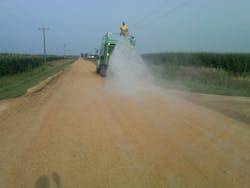Clinton County, Iowa, finds a stabilized road resurfacing solution
Clinton County, Iowa, Engineer Todd Kinney was looking for a solution for 250th Street, a 2-mile aggregate surfaced road that serves mainly residential and agricultural property. The road connects to two county farm-to-market paved roads and U.S. Highway 30. The 2010 traffic count was 70 ADT. The road is relatively flat with a traveled way width of 26 ft and typical shoulder and ditch cross sections.
In 2009, a large sand quarry opened and began operations. 250th Street is the only access road to the quarry site. The quarry generated an additional 20-30 trucks per day in comparison to the other daily traffic load of normal residential traffic and agricultural vehicle traffic. Due to the large increase in truck traffic, the road became difficult to maintain to the level of service expected by the mixture of road users.
Clinton County considered constructing an aggregate base and paving the road with hot mix asphalt, or increasing the aggregate replacement cycles and placement densities to support the increased truck traffic loading. The traffic count did not warrant paving and the funding was not available for a paving type of improvement.
The increased truck traffic on the road section was already requiring the county to increase aggregate re-surfacing cycles and increase road grading activity. Clinton County began researching for an intermediate level of service between a paved road surface and a typical aggregate surface that would support significant truck traffic on a year round basis. Clinton County selected Team Laboratory Chemical Corp.’s Base One as a treatment method to increase the level of service without the cost of paving.
The existing aggregate surface was scarified and then blade mixed with a Base One/water mixture. Additional water was also added to reach optimum moisture for compaction. The treated mix material was bladed to proper slope and then compacted with rubber tired rollers. Three additional 1-1/2 in. lifts of new aggregate were placed, stabilized, mixed and compacted in the same manner. All construction work was completed using existing county labor and equipment. The finished stabilized road was then treated with calcium chloride for dust mitigation.
“The Base One stabilization method was selected because it offers a higher level of service than a 'normal' aggregate road on a year-round basis, without the cost of paving the road,” stated Kinney.
“The Base One stabilization of the road has eliminated the need to re-apply aggregate to the road over the last four years. The road only requires blading twice a year - once in the spring and once in the fall. Ten maintenance blading cycles per year have been eliminated due to the stabilization of the road,” said Kinney.
Based on the unstabilized annual maintenance cost of the road and the current annual maintenance cost of the Base One stabilized road, the Base One stabilization has a rate of return of 8-10 years. The Base One stabilization is providing the county long-term maintenance cost savings, as well as providing a better year round driving surface to the traveling public.
